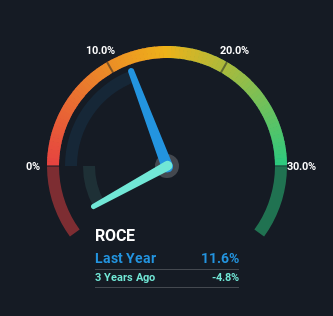- Taiwan
- /
- Tech Hardware
- /
- TWSE:6117
In Win Development (TWSE:6117) Is Looking To Continue Growing Its Returns On Capital
If we want to find a stock that could multiply over the long term, what are the underlying trends we should look for? In a perfect world, we'd like to see a company investing more capital into its business and ideally the returns earned from that capital are also increasing. Ultimately, this demonstrates that it's a business that is reinvesting profits at increasing rates of return. With that in mind, we've noticed some promising trends at In Win Development (TWSE:6117) so let's look a bit deeper.
Understanding Return On Capital Employed (ROCE)
For those who don't know, ROCE is a measure of a company's yearly pre-tax profit (its return), relative to the capital employed in the business. Analysts use this formula to calculate it for In Win Development:
Return on Capital Employed = Earnings Before Interest and Tax (EBIT) ÷ (Total Assets - Current Liabilities)
0.12 = NT$343m ÷ (NT$4.0b - NT$1.0b) (Based on the trailing twelve months to June 2024).
So, In Win Development has an ROCE of 12%. That's a relatively normal return on capital, and it's around the 11% generated by the Tech industry.
View our latest analysis for In Win Development

Historical performance is a great place to start when researching a stock so above you can see the gauge for In Win Development's ROCE against it's prior returns. If you're interested in investigating In Win Development's past further, check out this free graph covering In Win Development's past earnings, revenue and cash flow.
What Can We Tell From In Win Development's ROCE Trend?
The fact that In Win Development is now generating some pre-tax profits from its prior investments is very encouraging. About five years ago the company was generating losses but things have turned around because it's now earning 12% on its capital. And unsurprisingly, like most companies trying to break into the black, In Win Development is utilizing 105% more capital than it was five years ago. We like this trend, because it tells us the company has profitable reinvestment opportunities available to it, and if it continues going forward that can lead to a multi-bagger performance.
On a related note, the company's ratio of current liabilities to total assets has decreased to 25%, which basically reduces it's funding from the likes of short-term creditors or suppliers. So this improvement in ROCE has come from the business' underlying economics, which is great to see.
What We Can Learn From In Win Development's ROCE
To the delight of most shareholders, In Win Development has now broken into profitability. Since the stock has returned a staggering 604% to shareholders over the last five years, it looks like investors are recognizing these changes. Therefore, we think it would be worth your time to check if these trends are going to continue.
One more thing, we've spotted 2 warning signs facing In Win Development that you might find interesting.
While In Win Development isn't earning the highest return, check out this free list of companies that are earning high returns on equity with solid balance sheets.
New: AI Stock Screener & Alerts
Our new AI Stock Screener scans the market every day to uncover opportunities.
• Dividend Powerhouses (3%+ Yield)
• Undervalued Small Caps with Insider Buying
• High growth Tech and AI Companies
Or build your own from over 50 metrics.
Have feedback on this article? Concerned about the content? Get in touch with us directly. Alternatively, email editorial-team (at) simplywallst.com.
This article by Simply Wall St is general in nature. We provide commentary based on historical data and analyst forecasts only using an unbiased methodology and our articles are not intended to be financial advice. It does not constitute a recommendation to buy or sell any stock, and does not take account of your objectives, or your financial situation. We aim to bring you long-term focused analysis driven by fundamental data. Note that our analysis may not factor in the latest price-sensitive company announcements or qualitative material. Simply Wall St has no position in any stocks mentioned.
About TWSE:6117
In Win Development
Engages in processing, manufacturing, and trading of computer and peripheral equipment, and plastic products in Europe, the United States, Japan, Taiwan, and internationally.The company offers gaming and computer chassis, gaming and PC power supplies, IPC/servers, and cooling fans, as well as full, mid, mini, and micro tower chassis products.
Adequate balance sheet second-rate dividend payer.
Market Insights
Weekly Picks

THE KINGDOM OF BROWN GOODS: WHY MGPI IS BEING CRUSHED BY INVENTORY & PRIMED FOR RESURRECTION


Why Vertical Aerospace (NYSE: EVTL) is Worth Possibly Over 13x its Current Price


The Quiet Giant That Became AI’s Power Grid
Recently Updated Narratives

Growing between 25-50% for the next 3-5 years

SLI is share to watch next 5 years


The "Molecular Pencil": Why Beam's Technology is Built to Win
Popular Narratives


MicroVision will explode future revenue by 380.37% with a vision towards success


NVDA: Expanding AI Demand Will Drive Major Data Center Investments Through 2026




